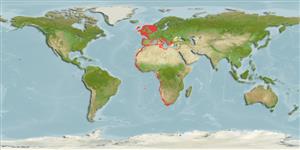Cephalopoda |
Myopsida |
Loliginidae
Environment: milieu / climate zone / ระดับความลึก / distribution range
นิเวศวิทยา
กลุ่มสัตว์หน้าดิน,กลุ่มสัตว์พื้นท้องน้ำ; ระดับความลึก 0 - 500 m (อ้างอิง 275), usually 20 - 250 m (อ้างอิง 275). Temperate; 13°C - 20°C (อ้างอิง 2453), preferred 18°C (อ้างอิง 107945); 60°N - 36°S, 19°W - 37°E
Eastern Atlantic and the Mediterranean: from North Sea and British Isles to southwest Africa and the Mediterranean.
Length at first maturity / ขนาด / Weight / Age
วัยเจริญพันธุ์: Lm 16.9, range 16 - 23 cm Max length : 64.0 cm ML เพศผู้/กระเทย; (อ้างอิง 417); 32 cm ML (female); น้ำหนักสูงสุดที่มีการรายงาน: 1.5 kg (อ้างอิง 275)
Paralarvae: Fins paddle-shaped, broad with short bases, fin much wider than long. Mantle broad with few large dorsal chromatophores and numerous ventral chromatophores. Head squarish with few chromatophores on dorsal surface and 12 chromatophores on ventral surface arranged in 2 cheek patches of 5 posterior to eyes and a pair between the eyes. Ventral arms with 2 aboral chromatophores. Tentacles with 4 aboral chromatophores. Tentacular clubs broad and wider than tentacular stalks. Mantle length at hatching range between mantle length 0.28 and 0.358 cm (Ref. 2489, 2490).
Juveniles and adults: Mantle muscular, cylindrical, slender and elongated posteriorly. Wide spots of red chromatophores in mantle and green/blue iridescence in posterior part of mantle. Fins rhomboid with length exceeding 50% of mantle length. Buccal membrane with 15 suckers with chitinous rings on extremity. Male's left ventral arm hectocotylized with length ranging from 15 to 33% of whole arm length. Arms with 2 rows of suckers, sucker rings with 20 teeth, distal ones large and pointed and proximal ones minute or absent. Tentacles not retractile and tentacular clubs with 4 longitudinal rows of suckers in the "manus", which in central rows are larger than marginal ones. Cartilages simple locking (Ref. 275, 1964).
Maximum life span: 1.5 to 2 years in females and 3 to 3.5 years in males (Ref. 2525). Maximum size for male, 64 cm, mantle length from Ref. 2494. Neither pelagic nor fully benthic. Inhabits circumlittoral zone and upper bottoms of bathyal systems (Ref. 2504). Exhibits benthic behavior during spawning season and pelagic behavior at other times, e.g., during hunting (Ref. 2493). Carnivorous predators (Ref. 2526); juvenile feeds on planktonic prey, e.g. copepods, mysids and euphausiids (Ref. 2525) while adult frequently feeds on fish (Ref. 2526) and sometimes on cephalopods and crustaceans.
Members of the class Cephalopoda are gonochoric. Male and female adults usually die shortly after spawning and brooding, respectively. Mating behavior: Males perform various displays to attract potential females for copulation. During copulation, male grasp the female and inserts the hectocotylus into the female's mantle cavity where fertilization usually occurs. Life cycle: Embryos hatch into planktonic stage and live for some time before they grow larger and take up a benthic existence as adults.
Piatkowski, U. 2006 Loligo vulgaris. European squid. Life history species review. CEPHSTOCK: Cephalopod Stocks in European Waters. Review, Analysis, Assessment and Sustainable Management. 25 p. (อ้างอิง 2488)
IUCN Red List Status
(อ้างอิง 130435: Version 2025-1)
CITES status (อ้างอิง 108899)
Not Evaluated
CMS (อ้างอิง 116361)
Not Evaluated
Threat to humans
Human uses
การประมง: การค้า
FAO - การประมง: landings | FishSource | ทะเลรอบๆเรา
เครื่องมือ
ข้อมูลเพิ่มเติม
Human RelatedStamps, coins, misc.
แหล่งที่มาจากอินเตอร์เน็ต
Estimates based on models
Preferred temperature
(Ref.
115969): 7.4 - 19.4, mean 11 (based on 1556 cells).
ความสามารถในการกลับคืนสู่ปกติ
ความสูง, เวลาต่ำสุดที่จะทำให้ประชากรเพิ่มขึ้นเป็น 2 เท่าใช้เวลาน้อยกว่า 15 เดือน (K=0.13-1.66; tm=0.78).
Prior r = 0.39, 95% CL = 0.26 - 0.58, Based on 2 full stock assessments.
Fishing Vulnerability
Low vulnerability (23 of 100).
Climate Vulnerability
High vulnerability (61 of 100).
Nutrients : Calcium = 126 [75, 177] mg/100g; Iron = 4.79 [1.67, 7.92] mg/100g; Protein = 15.5 [13.7, 17.4] %; Omega3 = 0.414 [0.262, 0.566] g/100g; Selenium = 57.8 [48.5, 67.2] μg/100g; VitaminA = 0 μg/100g; Zinc = 1.97 [0.92, 3.02] mg/100g (wet weight); based on
nutrient studies.
